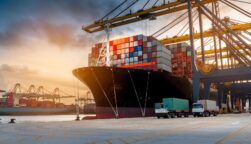President Trump has just backed down (somewhat) from his market-shattering new tariffs: He has just issued a 90-day pause on most of them.
Major economic rival China is not among the nations getting a stay of judgement, however, and Trump has just revealed the highest tax hike yet on Chinese imports. It now stands at a troubling 125%.
The news could be taken as an indication that Trump will respond to pushback against his widely disliked tariffs. However, the pause will only last 90 days. Barring further news, the tariffs will ultimately still remain a huge concern for countries and businesses everywhere.
The 10% Baseline Tariff Will Remain
According to a post from Trump on social media, he plans to use the 90-day pause to initiate trade talks. According to his post, the new pause is “based on the fact that more than 75 Countries have called Representatives of the United States” rather than retaliated with stronger terms such as the US tariffs imposed by China and the EU.
In the same statement, Trump said he’ll substantially lower the “Reciprocal Tariff” during the same 90-day period, keeping it to 10%, effective immediately.
 This just in! View
This just in! View
the top business tech deals for 2025 👨💻
The 10% tariff went into effect over the weekend as a baseline rate for most nation. Since it remains in place, the 90-day pause only applies to the many nation-specific additional tariffs that were announced at the same time.
The Market Is Back Up in Response
Trump’s latest tariffs took effect last Wednesday. At the time, they represented the highest effective tariff rate in the US in more than a century. With the new 125% tariff reveal, they’re up even further: Before the new announcement today, the China tariff was at 104%.
But the just-revealed pause on many tariffs has boosted the market, which has always had a pretty short memory.
At the time of writing, the Dow has surged 2,700 points, marking its biggest rally in five years. It needs it, given the days of declines that it has seen across the past week while the reality of the new tariffs sank in. However, plenty of negative market signals remain, and the market still remains in danger of continuing its decline.
Not Paused: De Minimis Removal, Other Tariffs
Not mentioned in Trump’s latest message? The de minimis exemptions, a key trade loophole that allowed small business owners like dropshippers or ecommerce brands like Temu to import products worth under $800 without additional duties. Trump officially revoked it last week, with the change going into effect in early May. Since he hasn’t yet issued on pause on this change, it’s still set to go through.
The same is true for previous tariffs, including a big 25% tariff on auto, steel, and aluminum imports. The baseline 10% tariff hike alone will represent a challenge for many businesses with thin margins, and a supply chain disruption could have wide ripples throughout the logistics industry.
Logistics Companies Face a More Than 100% Cost Increase on Chinese Imports
Not only is the de minimis exemption leaving next month — resulting in an effective hike of either 30% of an item’s or a flat $25 per item (which jumps to $50 per item in June), as we previously reported — but the additional China tariffs are sticking around as well.
And those tariffs in particular are so hefty as to completely disrupt most trade with China. Trump’s trade war has escalated multiple times across the last week, as both the US and China have issued retaliatory tariffs to the other nation’s products. Prior to Trump’s latest announcement of a 125% tariff on Chinese imports, China had raised its tariffs on the US to 84%, a response to the then-104% tariff from the US.
China is currently the US’s third-largest trade partner, after Canada and Mexico, and the US is China’s number one trade partner. But that seems set to change.
Dropshippers still have plenty of problems
What can dropshippers expect? They’ll likely be dropping their business with China, unless their margins are so much larger than 100% that they can eat the cost. Some dropshippers might be able to do just that, given that some do indeed have profit margins of 1000% or more, thanks to careful arbitrage.
Most, however, will need to pivot to a country that has just been granted a 90-day tariff reprieve. Even then, they’ll face the 10% baseline increase — and they’ll need to come up with a whole new plan in a scant three months, too.




